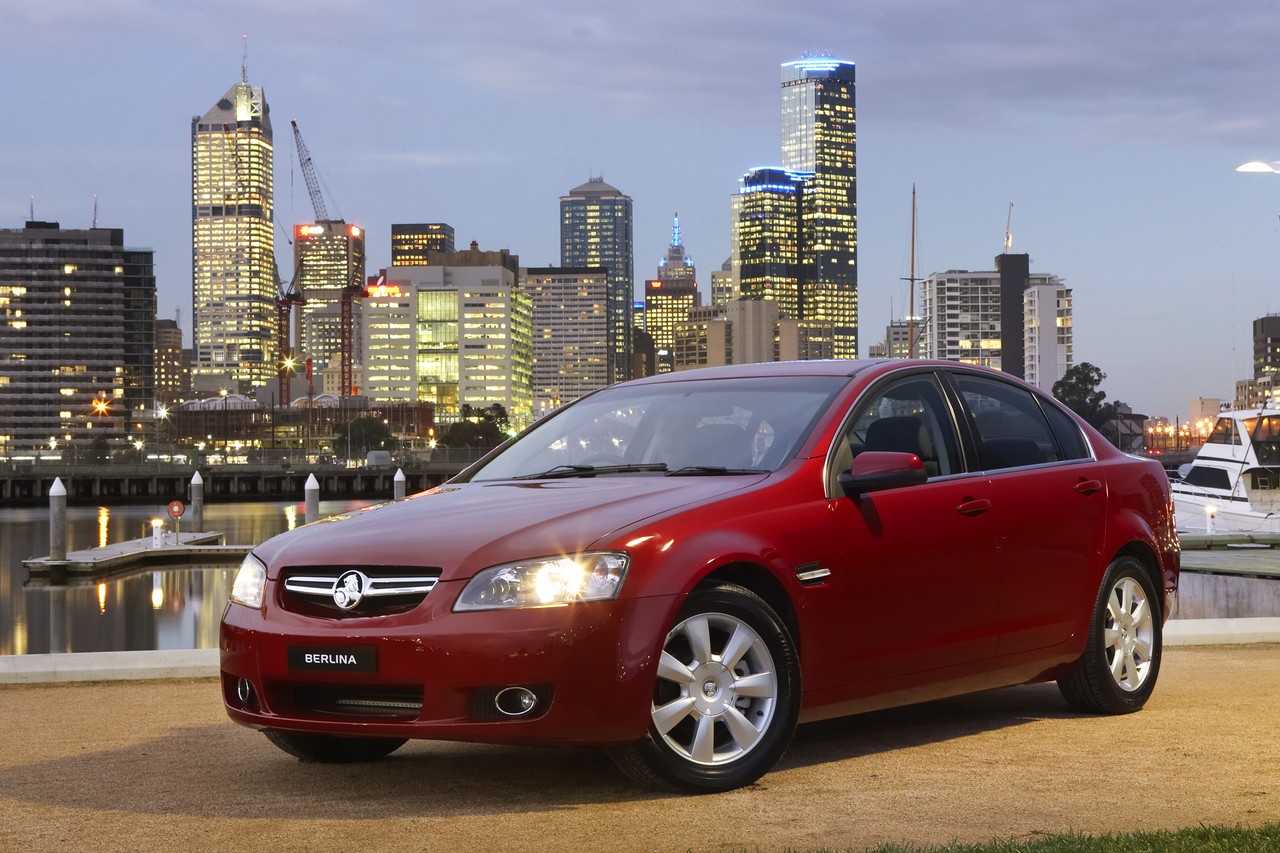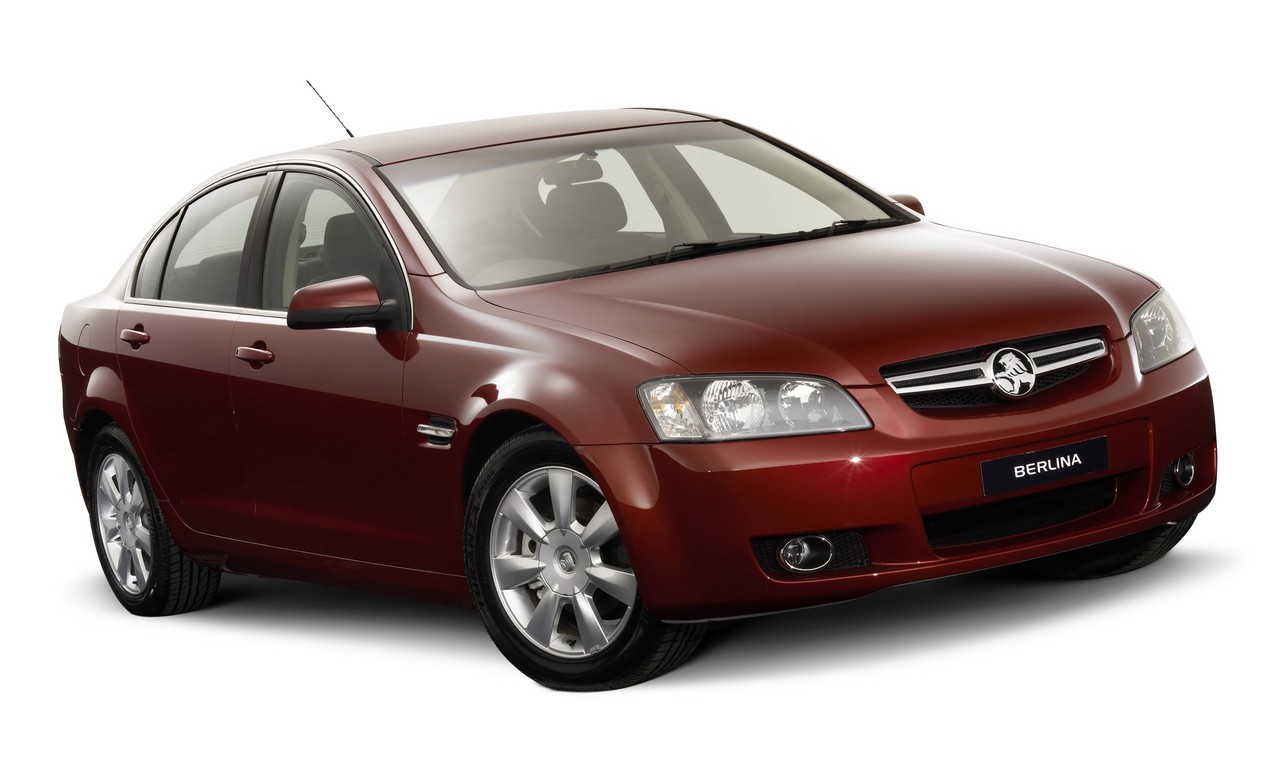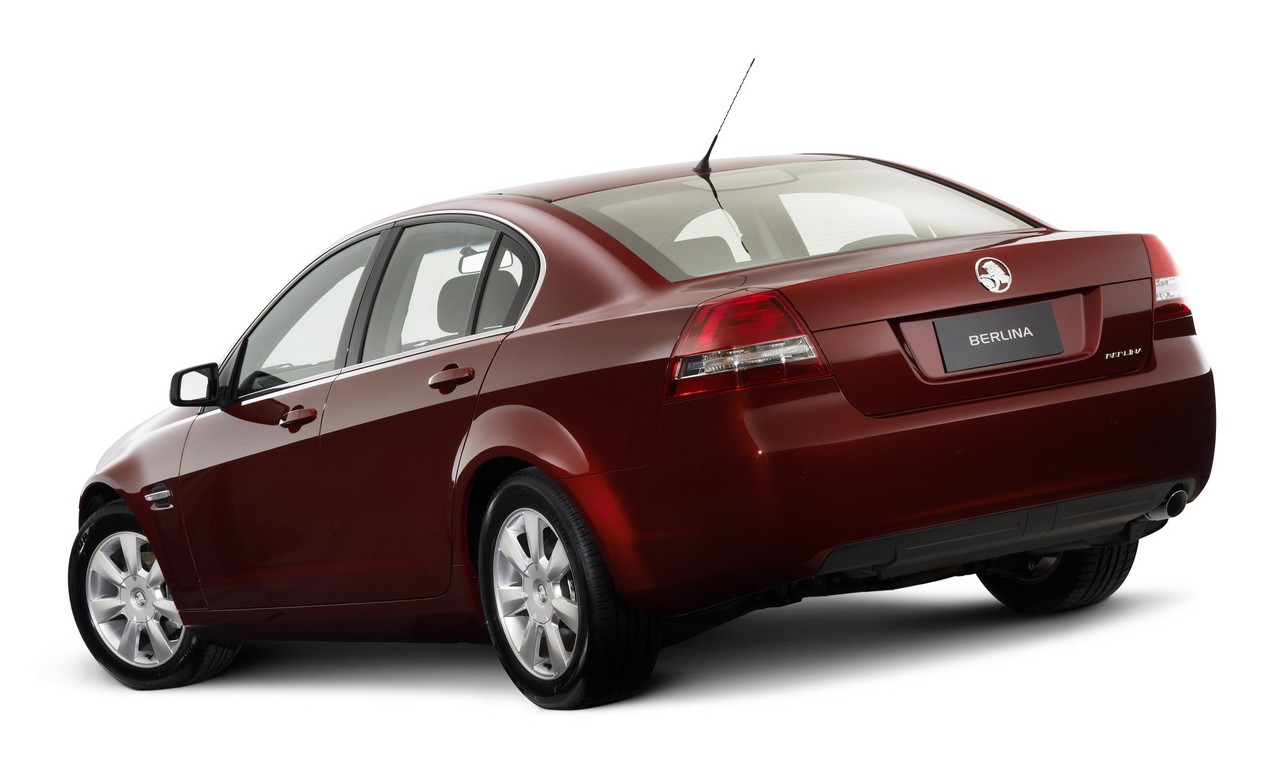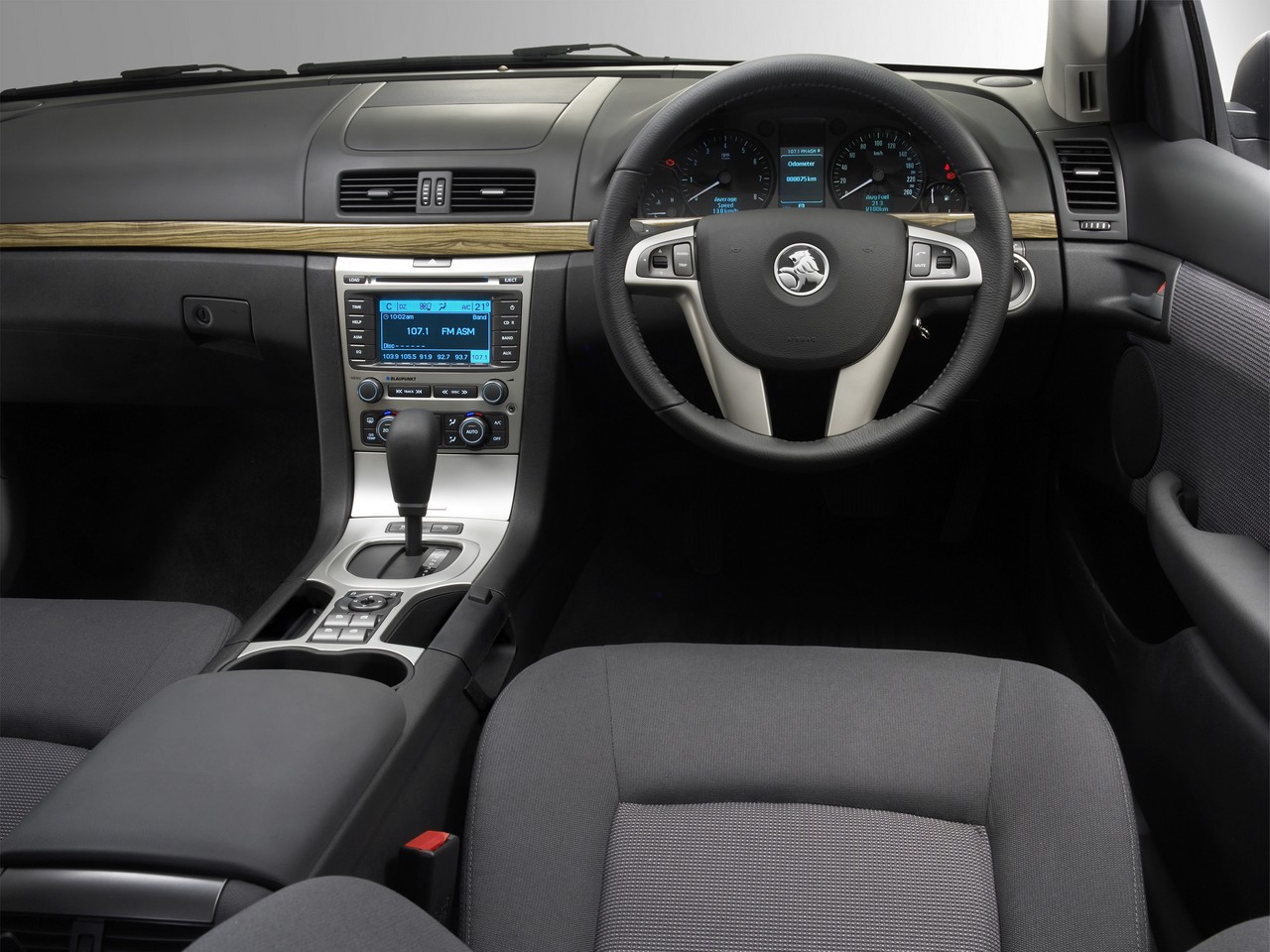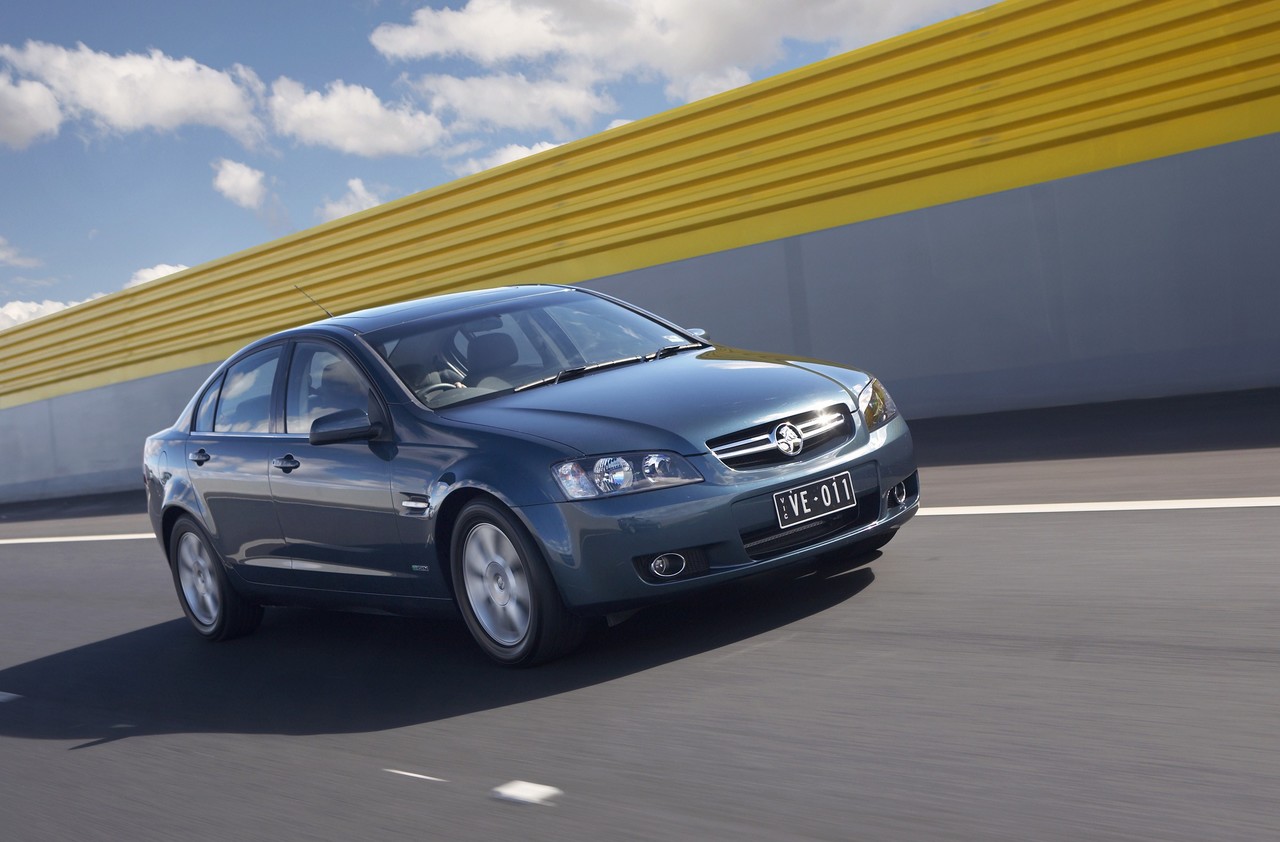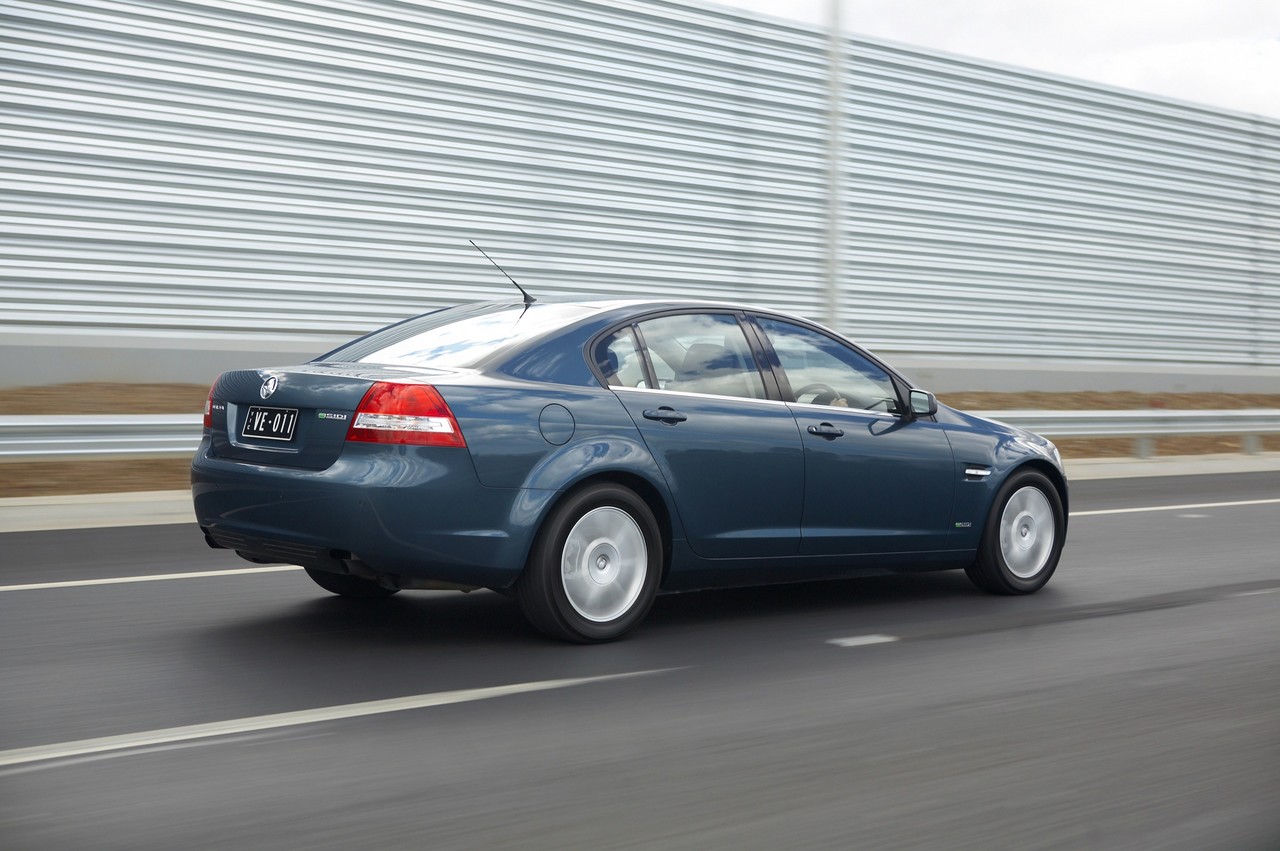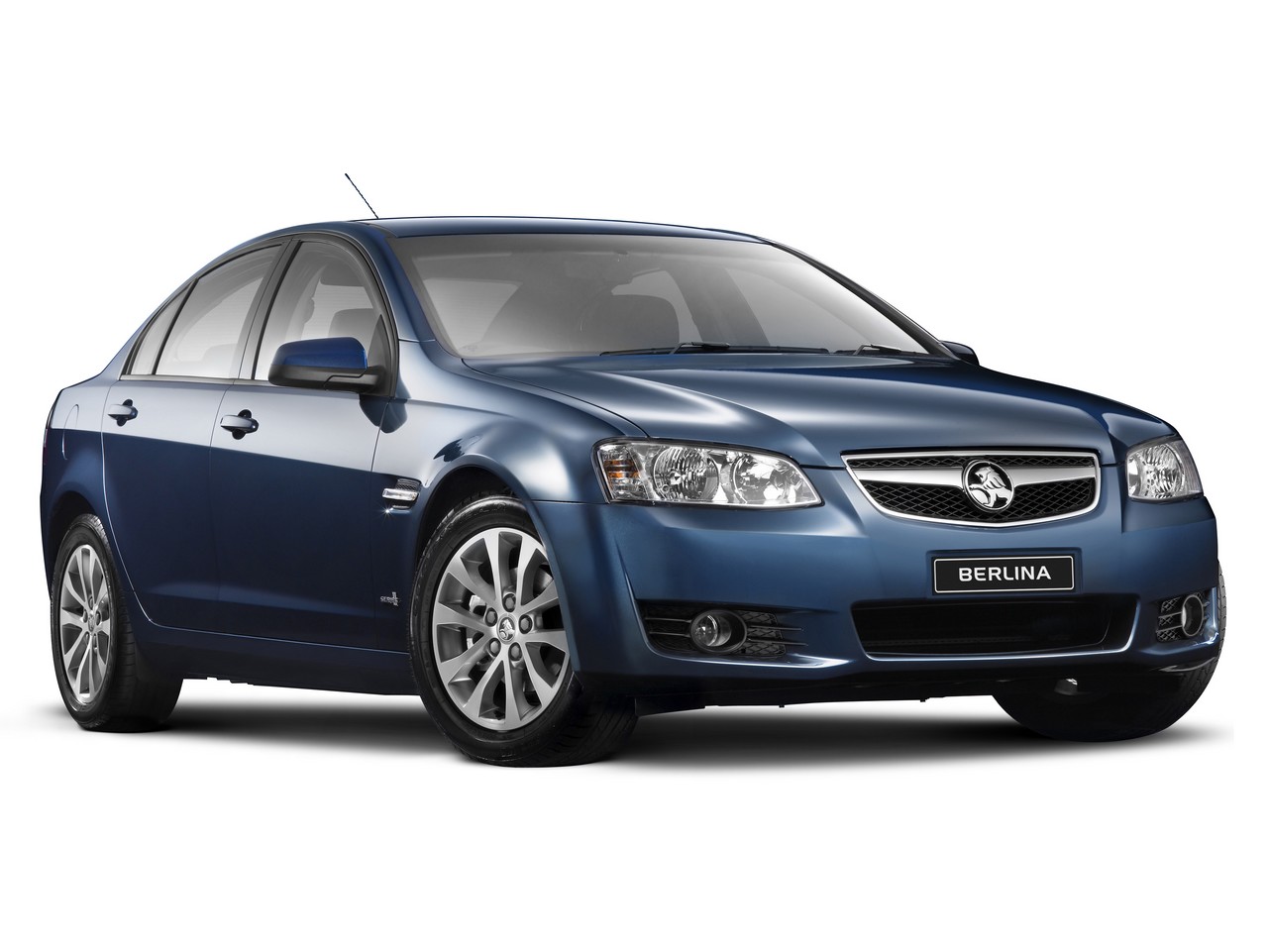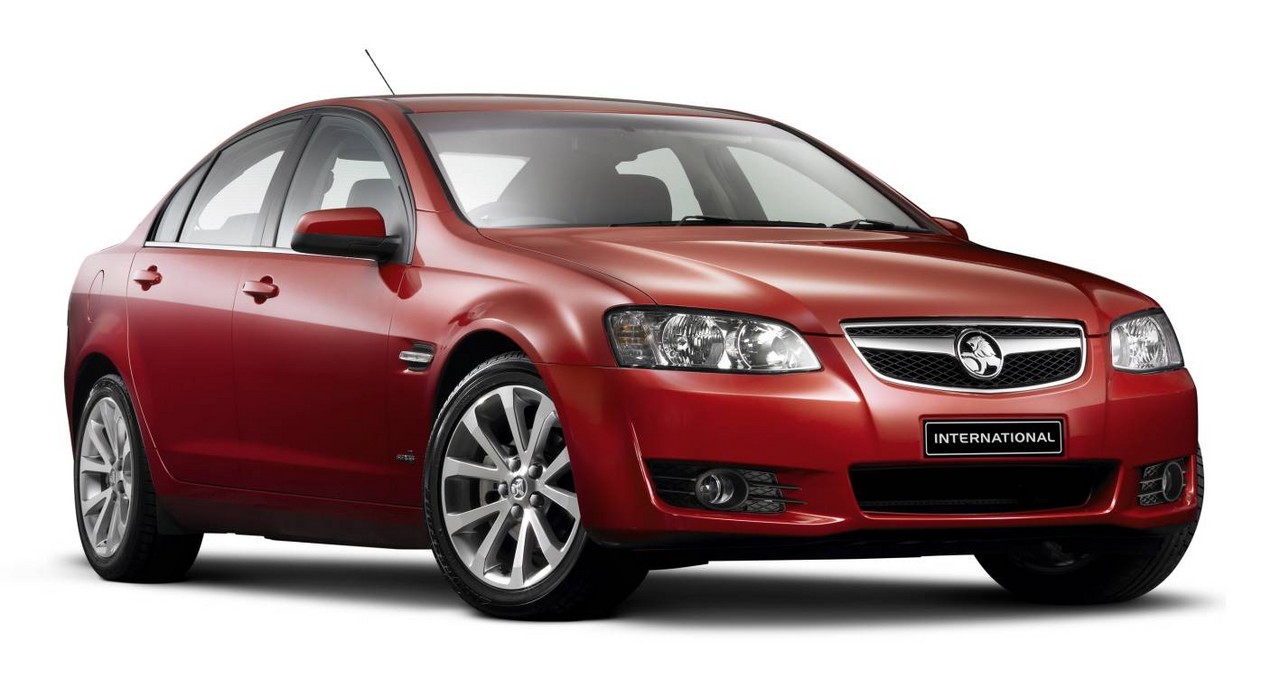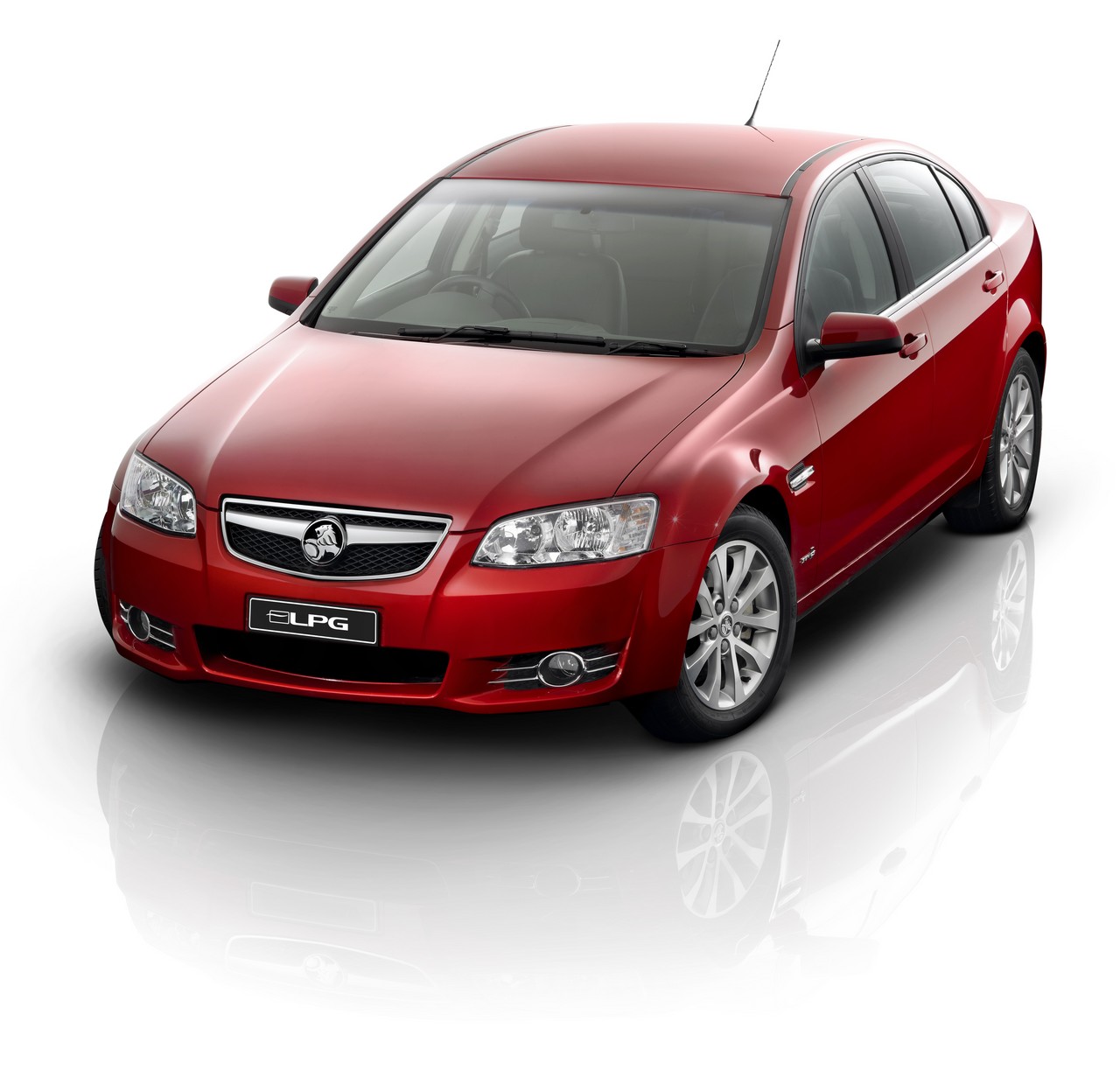
- Excellent ride/handling balance
- Powerful 6.0-litre L98 V8 engine
- Accurate, well-weighted steering
- Spacious and comfortable interior
- 3.6-litre ‘Alloytec’ V6 engines lack refinement
- Thick A-pillars impair forward visibility
- Awkward handbrake position and operation
- Clunky downshifts for four-speed automatic transmission
- Heavy body hurts fuel economy
- Carbon deposits on intake valves of direct injection V6 engines
Holden VE.I Berlina (2006-10)
Overview
Released in August 2006, the Holden VE Series I (VE.I) Berlina was a large drive sedan (the VE Sportwagon has been reviewed separately). Manufactured in Elizabeth, South Australia, the rear-wheel drive Berlina was initially available with 3.6-litre V6 and 6.0-litre V8 engines.
Engines: Alloytec V6 and L98 V8
Of the engines,
- TThe 3.6-litre ‘Alloytec’ LE0 V6 petrol engine had all-aluminium construction, a forged steel crankshaft, forged powdered metal connecting rods, double overhead camshafts (DOHC), sequential electronic fuel injection, four valves per cylinder, continuously variable intake camshaft phasing, electronic throttle control, twin knock control sensors and a compression ratio of 10.2:1. For the VE range, the Alloytec engines were fitted with new variable intake manifolds, Bosch E77 engine control systems with digital sensors for crank and camshaft positions, front and rear oxygen (O2) sensors, retuned harmonic balancers and free-flowing exhaust systems. In November 2008 (‘MY09.5’), the engine was modified for lower emissions and improved fuel economy.
- For Berlinas with the LE0 engine, buyers could specify a factory-fitted dual fuel (petrol/LPG) system that was developed by IMPCO and provided sequential vapour gas injection. Designated LW2 , the dual fuel engine had different valves and hardened titanium valve seats.
- In September 2009 (‘MY10’), the 3.6-litre petrol engines were replaced by 3.0-litre LF1 V6 petrol engines which had direct injection (Holden’s Spark Ignition Direct Injection or SIDI) whereby fuel was pressurised and injected directly into the combustion chamber compression. Furthermore, the 3.0-litre LF1 engine had variable exhaust camshaft phasing, a compression ratio of 11.7:1 and was fitted with a dual exhaust system; and,
- The 6.0-litre L98 pushrod V8 engine had all-aluminium construction, flat-topped pistons, forged powered metal connecting rods, a billet steel camshaft, two valves per cylinder, external knock sensors and a compression ratio of 10.4:1.
For the VE range, new engine control systems were introduced which used digital sensors for crank and camshaft positions. Service intervals for the V8 engines were also extended to 15,000 kilometres (previously 10,000 kilometres).
Transmissions
The 3.6-litre V6 engines were available with four-speed 4L60E automatic transmissions. For the 3.0-litre V6 engines, six-speed 6L50 automatic transmissions were fitted as standard. The V8 engines were fitted with six-speed 6L80 automatic transmissions which, like the 6L50 units, had an ‘Active Select’ function that enabled the driver to perform sequential gearshifts by tapping the gear shifter.
Development and dimensions
Developed in conjunction with the VE Commodore and underpinned by GM’s Zeta platform, the VE Berlina had a more rigid body – due to a higher proportion of advanced-strength steels – and an almost 50:50 weight distribution as the engine was positioned low and rearward within the engine bay, a saddle-style fuel tank was introduced and the battery was positioned in the rear of the vehicle.
For greater refinement, the VE Berlina had a stiffer engine cradle with six mounting points, acoustic laminated windscreens, new engine covers and bonnet insulators, new sound absorption packages (behind the engine bay and between the transmission and transmission tunnel), insulating carpets and a new double-isolated ZF differential. Tyre pressures were also increased to 250kPa (36.25 psi) to reduce rolling resistance and improve fuel economy.
Compared to the VZ Berlina , the VE Berlina was 70 mm shorter (at 4894 mm), 57 mm wider (1899 mm), 26 mm taller (1476 mm) and had a 127 mm longer wheelbase (2915 mm).
From September 2009, the VE.I Berlina was fitted with additional engine bay insulation, a quieter muffler and low rolling-resistance Bridgestone Turanza tyres for improved fuel economy.
Suspension
The VE Berlina had ‘Linear Control’ suspension which consisted of double-pivot MacPherson strut-based front suspension with dual lower links (with individual ball joints), a tension link, lateral link and a direct acting stabiliser bar. The rear suspension was a four-link independent system with coil-over shock absorbers, three lateral ball joints per side and a decoupled stabiliser bar. Like the Commodore Omega, the Berlina had a ‘comfort biased’ suspension tune.
In September 2009 (‘MY10’), the rear suspension was revised with an additional cross-axis ball joint (in place of a rubber bush in the lower control arm).
| Engine | Trans. | Production | Peak power | Peak torque |
|---|---|---|---|---|
| 3.6-litre LE0 petrol V6 | 4sp auto | Aug 2006 to Oct 2008 | 180 kW at 6000 rpm | 330 Nm at 2600 rpm |
| Nov 2008 to Sep 2009 | 175 kW at 6500 rpm | 325 Nm at 2400 rpm | ||
| 3.0-litre LF1 petrol V6 SIDI | 6sp auto | Sep 2009 to Aug 2010 | 190 kW at 6700 rpm | 290 Nm at 2900 rpm |
| 3.6-litre LW2 petrol/LPG V6 | 4sp auto | Oct 2006 to Oct 2008 | 175 kW at 6000 rpm | 325 Nm at 2600 rpm |
| Nov 2008 to Aug 2010 | 175 kW at 6500 rpm | 318 Nm at 2400 rpm | ||
| 6.0-litre petrol V8 (L98) | 6sp auto | Aug 2006 to Dec 2008 | 270 kW at 5700 rpm | 530 Nm at 4400 rpm |
Safety equipment
Initially, standard safety equipment for the VE Berlina included dual front airbags, front side airbags, ABS, electronic brake force distribution, brake assist, electronic stability control, traction control and front seatbelts with pretensioners and load limiters.
From March 2008, the Berlina was also fitted with full-length curtain airbags (i.e. for front and rear occupants) as standard. From November 2008, the Berlina was fitted with an energy-absorbing steering column shroud.
Brakes
VE Berlina models with V6 engines had 298 mm by 30 mm ventilated front brake discs with twin-piston callipers and 302 mm by 22 mm ventilated rear discs with single-piston callipers. Models with V8 engines, however, had 321 mm by 30 mm front discs and 324 mm by 22 mm rear discs.
ANCAP crash testing
In ANCAP crash testing , post-November 2008 Berlinas – fitted with six airbags, the steering column shroud and a passenger seatbelt reminder – were awarded a five star adult occupant protection rating with a score of 33.45 out of 37 based on ANCAP testing of the Holden VE Commodore Omega. In the offset crash test, there was a slight risk of serious chest and lower leg injury for the driver. In the side impact and pole tests, maximum points were awarded.
Prior to this, the most relevant ANCAP crash testing result is the four star adult occupant protection rating received by a 2007 VE.I Commodore Omega – with a score of 27.45 out of 37 – though the Omega tested was not fitted with front side airbags as per the Berlina.
Features
Standard Berlina features included 17-inch alloy wheels, a seven speaker sound system with CD player, MP3-compatibility and auxiliary inputs, dual zone climate control air conditioning, a power adjustable driver’s seat, Bluetooth connectivity, cruise control, rear parking sensors, remote central locking, automatic headlights, front fog lights, a height and reach adjustable leather-wrapped steering wheel, power windows and mirrors, a trip computer and an immobiliser. Initially, the Berlina featured a woodgrain strip across its dashboard, though this was replaced by a matte silver insert in April 2007 (‘MY08’).
From March 2009, the space-saver spare tyres was discontinued and replaced with – at the buyer’s choice – either an inflation kit or full-size spare.
Brochures
- Brochure: Holden VE.I Commodore, Berlina and Calais (July 2006)
- Features: Holden VE.I Berlina and Calais (July 2006)
- Brochure: Holden VE.I Berlina and Calais (October 2008)
Related links
- Holden Media Archive: More Power, More Torque, More Refinement For New Commodore Range (July 2006)
- Holden Media Archive: New Six-Speed Automatic Transmission For V8 Commodores (July 2006)
- Holden Media Archive: Sophisticated New Suspension System For Commodore (July 2006)
- Holden Media Archive: Safety The Priority For Commodore Development (July 2006)
- Holden Media Archive: Improved Fuel Efficiency For Commodore (October 2008)
- Holden Media Archive: Fuel Saving Technology For V8 Automatic Range From 2009 (October 2008)
- Holden Media: Holden VE/WM MY10 Product Information (September 2009)
Holden VE.II Berlina (2010-13)
Overview
Released in September 2010, the VE Series II (VE.II) Berlina introduced an updated interior with additional features, the flex-fuel capable LFW V6 engine and improved fuel consumption. Replacing the LF1 engine, the 3.0-litre LFW engine could run on a mixture of petrol and ethanol up to E85 (i.e. 85 per cent ethanol and 15 per cent petrol). Although ethanol has a lower energy density than petrol, its higher octane rating enables it to provide greater performance.
Fuel consumption for the Berlina was improved through improved aerodynamics, including underfloor air flow panels, rear wheel air deflectors and a clutched air conditioning compressor. Visually, the VE.II Berlina could be identified by its squarer front fascia, reshaped headlights, more prominent grille with chrome cross crossbar and ‘aero lip’ boot.
November 2011 update (MY12): 6L45 transmission
In November 2011, the following changes were introduced for improved fuel efficiency:
- The six-speed 6L50 transmission was replaced by the more efficient 6L45 unit;
- For models with the 3.0-litre LFW V6 engine, a revised torque converter was introduced; and,
- The air conditioning system was re-engineered to improve efficiency and draw less power.
LWR dedicated LPG engine
In February 2012, the dual fuel LW2 V6 engine was replaced by the dedicated LPG LWR . The 3.6-litre LWR engine had multi-point vapour injection (rather than liquid injection as per the Ford FG Falcon ‘s ‘LPI’ engine) which heated the gas immediately prior to injection. Compared to the 3.6-litre LY7 engine, the dedicated LPG engine had hardened valves and valve seats, a redesigned cylinder head and manifold for improved air flow, variable exhaust valve timing, specially-developed fuel injectors, new pistons with pentroof-style domes, a compression ratio of 12.2:1, a new fuel rail and new LPG fuel filter. Like other models with V6 engines, the LWR engine was also mated to the six-speed 6L45 automatic transmission.
To alleviate concerns over range, the dedicated LPG Berlinas were fitted with an 84-litre twin cylinder fuel tank manufactured from high-strength, aircraft-grade extruded aluminium. To accommodate the tank, the spare wheel was omitted and a puncture repair kit was provided. Models with the dedicated LPG engine also had a single pipe exhaust system to conserve mass.
| Engine | Years | Trans. | Peak power | Peak torque |
|---|---|---|---|---|
| 3.0-litre LFW petrol/E85 V6 | 2010-13 | 6sp auto | 190 kW at 6700 rpm | 290 Nm at 2900 rpm |
| 3.6-litre LW2 petrol/LPG V6 | 2010-11 | 4sp auto | 175 kW at 6500 rpm | 318 Nm at 2400 rpm |
| 3.6-litre LWR LPG V6 | 2012-13 | 6sp auto | 180 kW at 6000 rpm | 320 Nm at 2000 rpm |
Features
Standard features for the VE.II Berlina were extended to include new 17-inch machined alloy wheels, a 6.5-inch colour touch-screen Holden-iQ system with single CD player, MP3-compatibility, 1 GB flash drive, USB and auxiliary inputs, integrated iPod support, Bluetooth audio streaming, touch-screen dialing, enhanced Bluetooth mobile phone connectivity and new seats with ‘Sportec’ bolsters and fabric inserts.
2010 VE.II Berlina International
In November 2010, a limited-run International edition of the Berlina was released; the Berlina International was distinguished by its 18-inch quad twin-spoke alloy wheels, Onyx leather seat trim and rear view camera.
November 2011: Berlina MY12
In addition to the mechanical changes described above, the iQ media interface was enhanced in November 2011 with improved Bluetooth connectivity and smartphone-compatibility updates.
Visually, the updated Berlina could be identified by its chrome fog-light surrounds and silver seat stitching for leather trim (where fitted).
Brochure
Related links
- Holden Media: VE Series II – The future friendly Commodore (August 2010)
- Holden Media: New Berlina International Models Hit The Mark (November 2010)
- Holden Media: Model Year 12 Commodore (November 2011)
- Wikipedia.org: Holden VE Commodore
